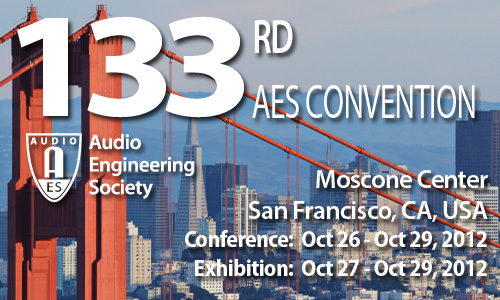
AES San Francisco 2012
Paper Session P1
Friday, October 26, 9:00 am — 11:00 am (Room 121)
Paper Session: P1 - Amplifiers and Equipment
Chair:
Jayant Datta, THX - San Francisco, CA, USA; Syracuse University - Syracuse, NY, USA
P1-1 A Low-Voltage Low-Power Output Stage for Class-G Headphone Amplifiers—Alexandre Huffenus, EASii IC - Grenoble, France
This paper proposes a new headphone amplifier circuit architecture, which output stage can be powered with very low supply rails from ±1.8 V to ±0.2 V. When used inside a Class-G amplifier, with the switched mode power supply powering the output stage, the power consumption can be significantly reduced. For a typical listening level of 2x100µW, the increase in power consumption compared to idle is only 0.7mW, instead of 2.5mW to 3mW for existing amplifiers. In battery-powered devices like smartphones or portable music players, this can increase the battery life of more than 15% during audio playback. Theory of operation, electrical performance and a comparison with the actual state of the art will be detailed.
Convention Paper 8684 (Purchase now)
P1-2 Switching/Linear Hybrid Audio Power Amplifiers for Domestic Applications, Part 2: The Class-B+D Amplifier—Harry Dymond, University of Bristol - Bristol, UK; Phil Mellor, University of Bristol - Bristol, UK
The analysis and design of a series switching/linear hybrid audio power amplifier rated at 100 W into 8 O are presented. A high-fidelity linear stage controls the output, while the floating mid-point of the power supply for this linear stage is driven by a switching stage. This keeps the voltage across the linear stage output transistors low, enhancing efficiency. Analysis shows that the frequency responses of the linear and switching stages must be tightly matched to avoid saturation of the linear stage output transistors. The switching stage employs separate DC and AC feedback loops in order to minimize the adverse effects of the floating-supply reservoir capacitors, through which the switching stage output current must flow.
Convention Paper 8685 (Purchase now)
P1-3 Investigating the Benefit of Silicon Carbide for a Class D Power Stage—Verena Grifone Fuchs, University of Siegen - Siegen, Germany; CAMCO GmbH - Wenden, Germany; Carsten Wegner, University of Siegen - Siegen, Germany; CAMCO GmbH - Wenden, Germany; Sebastian Neuser, University of Siegen - Siegen, Germany; Dietmar Ehrhardt, University of Siegen - Siegen, Germany
This paper analyzes in which way silicon carbide transistors improve switching errors and loss associated with the power stage. A silicon carbide power stage and a conventional power stage with super-junction devices are compared in terms of switching behavior. Experimental results of switching transitions, delay times, and harmonic distortion as well as a theoretical evaluation are presented. Emending the imperfection of the power stage, silicon carbide transistors bring out high potential for Class D audio amplification.
Convention Paper 8686 (Purchase now)
P1-4 Efficiency Optimization of Class G Amplifiers: Impact of the Input Signals—Patrice Russo, Lyon Institute of Nanotechnology - Lyon, France; Gael Pillonnet, University of Lyon - Lyon, France; CPE dept; Nacer Abouchi, Lyon Institute of Nanotechnology - Lyon, France; Sophie Taupin, STMicroelectronics, Inc. - Grenoble, France; Frederic Goutti, STMicroelectronics, Inc. - Grenoble, France
Class G amplifiers are an effective solution to increase the audio efficiency for headphone applications, but realistic operating conditions have to be taken into account to predict and optimize power efficiency. In fact, power supply tracking, which is a key factor for high efficiency, is poorly optimized with the classical design method because the stimulus used is very different from a real audio signal. Here, a methodology has been proposed to find class G nominal conditions. By using relevant stimuli and nominal output power, the simulation and test of the class G amplifier are closer to the real conditions. Moreover, a novel simulator is used to quickly evaluate the efficiency with these long duration stimuli, i.e., ten seconds instead of a few milliseconds. This allows longer transient simulation for an accurate efficiency and audio quality evaluation by averaging the class G behavior. Based on this simulator, this paper indicates the limitations of the well-established test setup. Real efficiencies vary up to ±50% from the classical methods. Finally, the study underlines the need to use real audio signals to optimize the supply voltage tracking of class G amplifiers in order to achieve a maximal efficiency in nominal operation.
Convention Paper 8687 (Purchase now)
